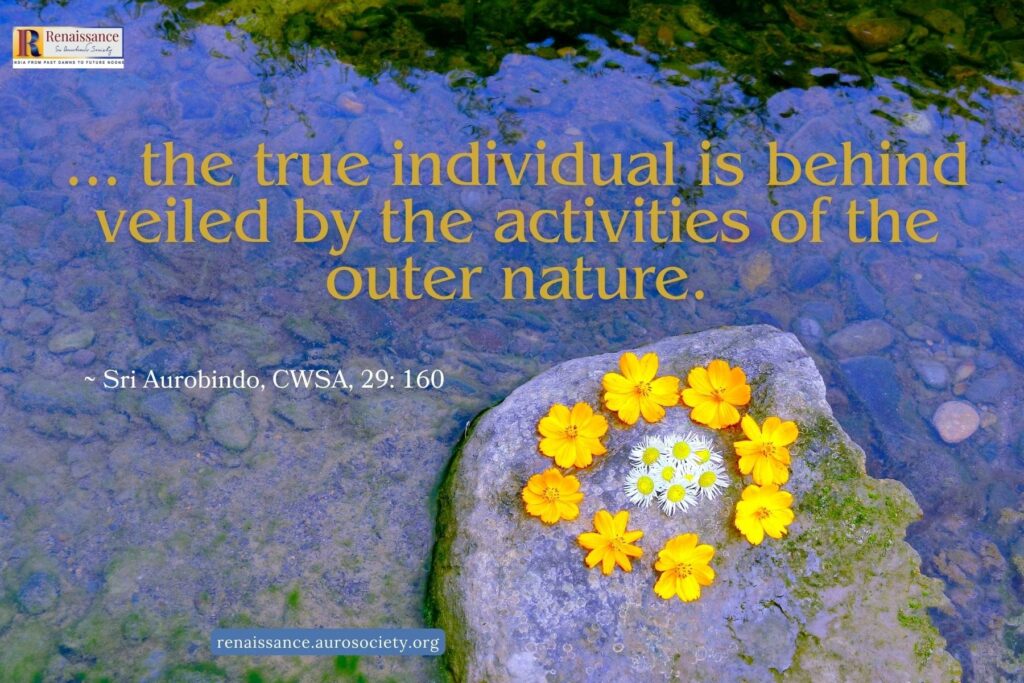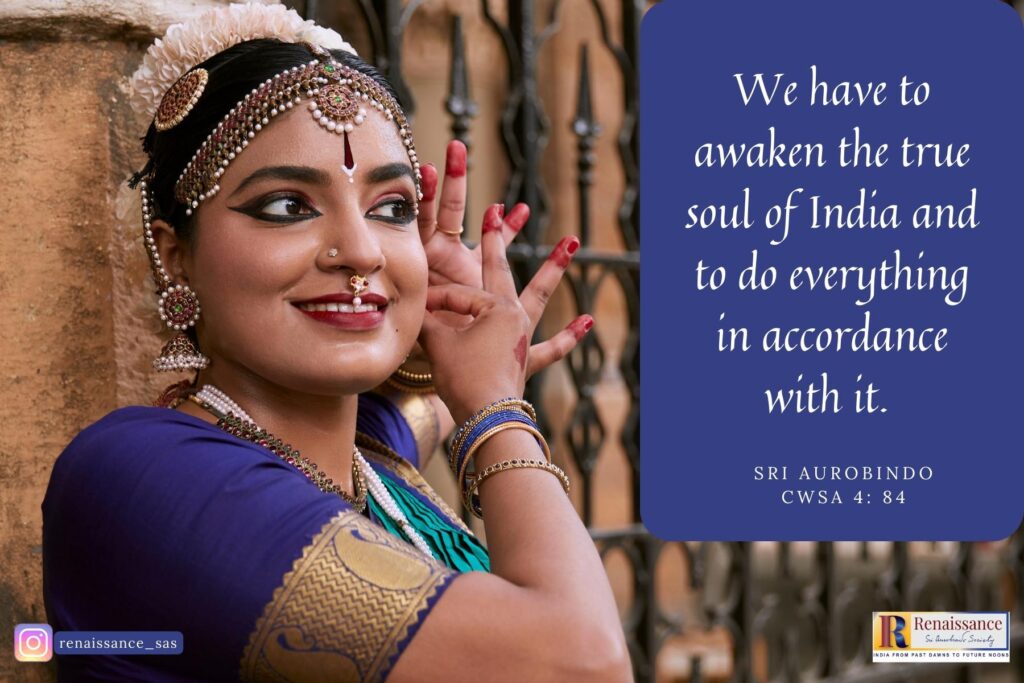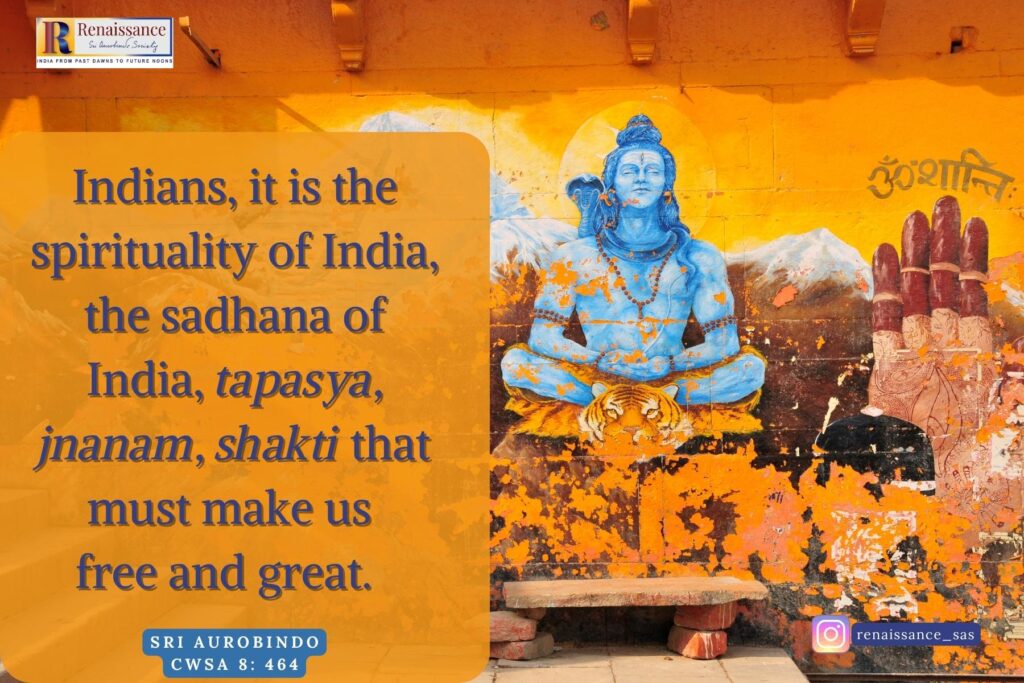CONTINUED FROM PART 2

Insights for Education Today and Tomorrow
New Education Policy 2020 emphasises sports-integration as an important cross-curricular pedagogical approach.
The need to integrate sports in education is well recognized as it serves to foster holistic development by promoting physical and psychological well-being while also enhancing cognitive abilities.
(NEP 2020, pp. 12-13)
The policy document also highlights the need to revive indigenous sports and games of India through education. A well-designed physical education not only helps learners develop skills such as collaboration, self-initiative, self-direction, self-discipline, teamwork, responsibility, etc. but also help them adopt fitness as a lifelong attitude and to achieve the related life skills along with the levels of fitness.
To ensure that our youth blossom into healthy, capable and self-controlled human beings, who can consistently grow in shakti and contribute constructively to the upliftment of their motherland and humanity at large, we must help them gain greater understanding of how to regulate, channelise and sublimate their abundant youthful energies.
This cannot be done by adding bigger and bigger loads of mental information to the students’ course of studies. Rather the need is to carefully and consciously educate their natural life instincts and body impulses.
In most of our mainstream educational institutions, these parts of the student’s nature are left to themselves. Educators either do not dare or care to handle them consciously, or they themselves are simply unaware as to how to proceed. It is time we re-evaluated the deep significance of the principle of brahmacharya and make it an important part of the overall educational experience of our children and youth.
Nolini Kanta Gupta, in an essay titled ‘Brahmacharya’ gives us immensely valuable clarity on this subject:
It must be understood that this discipline [of brahmacharya] is not merely for those who wish to follow a religious or spiritual life, but for all without exception…. It is the secret fund of strength, the source of pure energies that vitalises life, enhances its values, makes it worth living. The energy that one stores by continence, regular habits and self-discipline increases also in that way.
Sometimes special methods –kriya – are adopted to help the process, Asana or Pranayama, for example. But an inner and a more psychological procedure is needed, a concentration of will and consciousness – a kind of dhyana, in other words – in order to be able to take the next step in discipline. For after the storage and increase of energy comes the sublimation of energy, that is to say, the physico-vital energy transmuted into the energy of mental substance, medha.
Sublimation means also the increase of brain-power, an enhancement in the degree and quality of its capacity. …the growth is with regard to the very stuff of the mind from within, the natural strength of intelligence that can be applied to any field of knowledge with equal success and felicity.
The basis and the immediate aim of education according to the ancient system was to develop this fundamental mental capacity: the brain’s power to think clearly, consistently and deeply, to undergo labour without tiring easily and also a general strength and steadiness in the nerves. The transference of nervous energy into brain energy is also a secret of the process of sublimation. It is precisely this aspect of education that has been most neglected in modern times.
We give no thought to this fundamental: we leave the brain to develop as it may (or may not), it is made to grow under pressure – more to inflate than to grow – by forcing into it masses of information. The result at best is that it is sharpened, made acute superficially or is overgrown in a certain portion of it in respect of a narrow and very specialised function, losing thereby a healthy harmony and homogeneity in the total movement. The intellectual’s nervous instability is a very common phenomenon among us.
~ Collected Works of Nolini Kanta Gupta, 1: 269-272

Of Freedom and Discipline
Progressive thought in education today gives much significance, and rightly so, to the values of freedom and autonomy with regard to the overall development of the child. But in the absence of a strong sense of self-discipline and self-control such an approach often results in gross misuse or abuse of freedom and autonomy. What is often spoken of as individual freedom today is more slavery than freedom, slavery to our commonplace animal nature. To follow one’s impulses and instincts freely is not true freedom at all.
Some element of discipline and order must be part of a well-designed approach to holistic education, but the question is how to practically incorporate it.
In ancient times this could be done because the student also led the life of an aspirant, living in the house of the teacher, in the atmosphere of his direct presence and influence. The teacher was also not doing his work in a mechanical manner, but ideally was someone who genuinely cared for and loved the students in his charge and took great pains to ensure their overall development.
For today’s students, life and study are two separate things with nothing to connect them. There is life and then there is school. One may be a good student and attain great intellectual achievement, yet in life one may remain quite ordinary with very normal reactions.
There has to be a healing of this separation between the intellectual culture and life movement. Nolini Kanta Gupta reminds that in order to unify the human personality, the training given under brahmacharya can be of immense help. The deeper purpose, however, of brahmacharya is a heightening, lifting the personality to a level of consciousness from where it can envisage its spiritual destiny and seek to realise it.
Read:
Insights from Indian Psychology for Personality Development of the Learner
Vital Education for Greater Self-control
A judicious control of the senses is also an important aspect of the practice of brahmacharya. A progressive system of education must include this aspect, to help youngsters develop greater self-control and greater mastery over their senses.
Using the terminology of Integral Yoga, this primarily means mastering the impulses of the lower vital part in us which is made up of the smaller movements of human life-desire and life-reactions, and which is occupied with small desires and feelings, such as food desire, sexual desire, small likings, dis-likings, vanity, quarrels, love of praise, anger at blame, little wishes of all kinds, etc.
We need proper education in sublimating the lower vital impulses, and also in refining and purifying the different instincts of the vital so that this part becomes a true instrument for our overall growth and development as a human being. Unfortunately, modern education does not really address adequately this topic of vital education.
In complete harmony with what our ancient seers and sages had put into practice in their gurukula-s through emphasis on brahmacharya, the Mother emphasises that proper vital education must begin as early as possible, as soon as a child is able to use his or her senses. This will help prevent the formation of many bad habits; and many harmful influences could be eliminated. A proper vital education must address two key aspects: the development and use of the sense organs; and the progressing awareness and control of the character, culminating in its transformation.
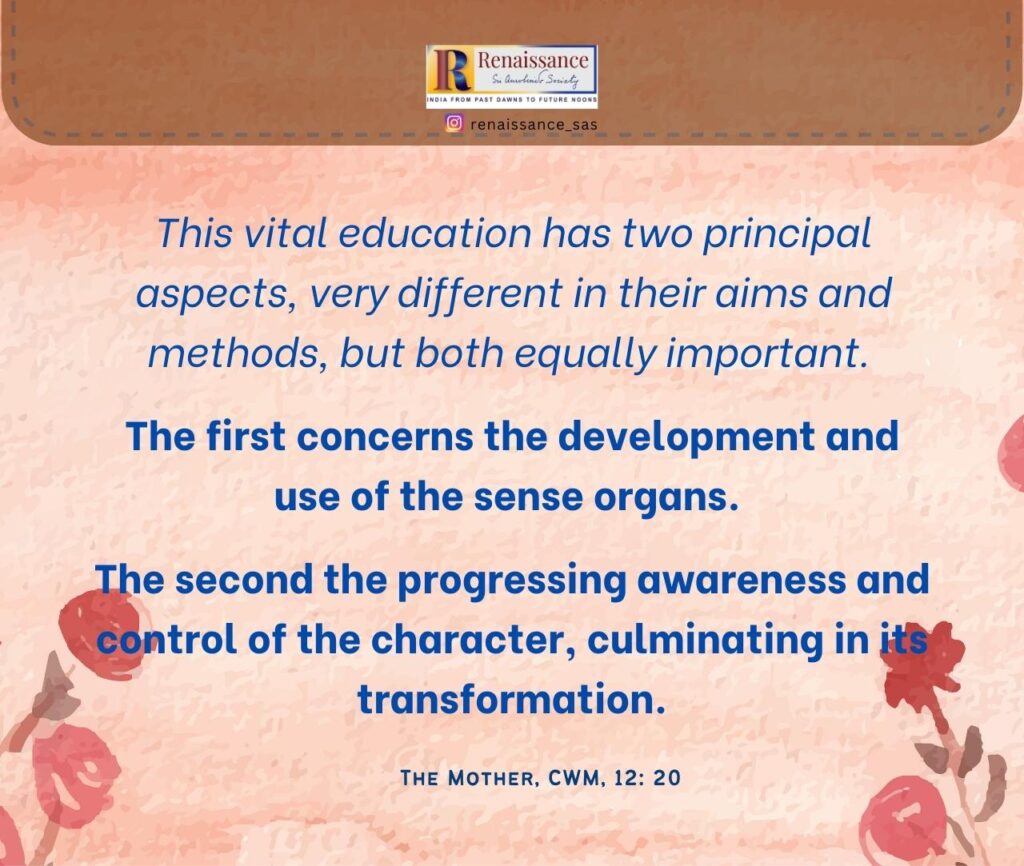
SEE:
Role of Art and Beauty in Vital Education
The different sense organs can be properly cultivated through thoughtful learning activities which involve the use of close and clear observation, refining one’s speech, developing deep listening, etc. Such cultivation can help the person attain a greater precision and power of functioning of his or her senses. Also, equal emphasis must be given to the cultivation of a sense of discrimination and of the aesthetic sense.
Learners must be given opportunities to develop the capacity to choose and adopt what is beautiful and harmonious, simple, healthy and pure.
Beauty and harmony of the sensations leads to better psychological health and also helps protect the child from the degrading influences in the long run. As the Mother writes:
As the capacity of understanding grows in the child, he should be taught, in the course of his education, to add artistic taste and refinement to power and precision. He should be shown, led to appreciate, taught to love beautiful, lofty, healthy and noble things, whether in Nature or in human creation. This should be a true aesthetic culture, which will protect him from degrading influences…
As a sign, perhaps, of the decline of civilisation and social decay, a growing vulgarity seems to have taken possession of human life, individual as well as collective, particularly in what concerns aesthetic life and the life of the senses. A methodical and enlightened cultivation of the senses can, little by little, eliminate from the child whatever is by contagion vulgar, commonplace and crude.
This education will have very happy effects even on his character. For one who has developed a truly refined taste will, because of this very refinement, feel incapable of acting in a crude, brutal or vulgar manner. This refinement, if it is sincere, brings to the being a nobility and generosity which will spontaneously find expression in his behaviour and will protect him from many base and perverse movements.
~ CWM, Vol. 12, p. 21
We may also note that development of an aesthetic sensibility and cultivation of refined taste involves judicious selection of the various sensory influences to which a learner is exposed. Most of the popular cultural products these days, particularly films and music are meant primarily to create greater stimulation of senses and ends up bringing down the consciousness. Due diligence must be done by the parents and teachers in this regard.
With regard to the second aspect of vital education, namely, the transformation of the character, generally we see approaches which involve coercion, suppression, abstinence or asceticism. But such procedures, though certainly easier and quicker, are not necessarily enduring and effective. Additionally, such practices lead to a drying up of the vital part within the learner and for an overall growth one needs the active collaboration of the vital because that is also the source of dynamism and creative energy.
Often the biggest mistake made is when a separate moral education or value education programme is introduced for students. This add-on approach doesn’t work, especially when there is a great deal of sermonising along with so-called “moral education” textbooks.
Such a bookish approach makes the thinking of high things mechanical and artificial, and therefore, doesn’t carry any long-term value. Moral training can’t be ‘imparted’ in the same way as the training of the mind, because the “heart is not the mind and to instruct the mind does not necessarily improve the heart.” (Sri Aurobindo, CWSA, Vol. 1, p. 389)
READ:
Sri Aurobindo on Education for Character Development
Sri Aurobindo emphasises that the first rule of moral training is to suggest and invite, not command or impose. For a character-building education to have its full force, it is important that the learners are given an opportunity, within their limited sphere, of embodying in action the moral impulses which rise within them.
This demands a great overhaul in the present system.
To begin with, it necessitates a much smaller class size than what we see in most schools in India. It requires a great deal of individualized attention by the teachers, a patient approach and a pedagogy that values love and genuine caring for each learner. It places great responsibility on the teachers for their own growth and character development. A thoughtful curricular decision-making process and a careful approach to designing learning activities in the classroom are essential.
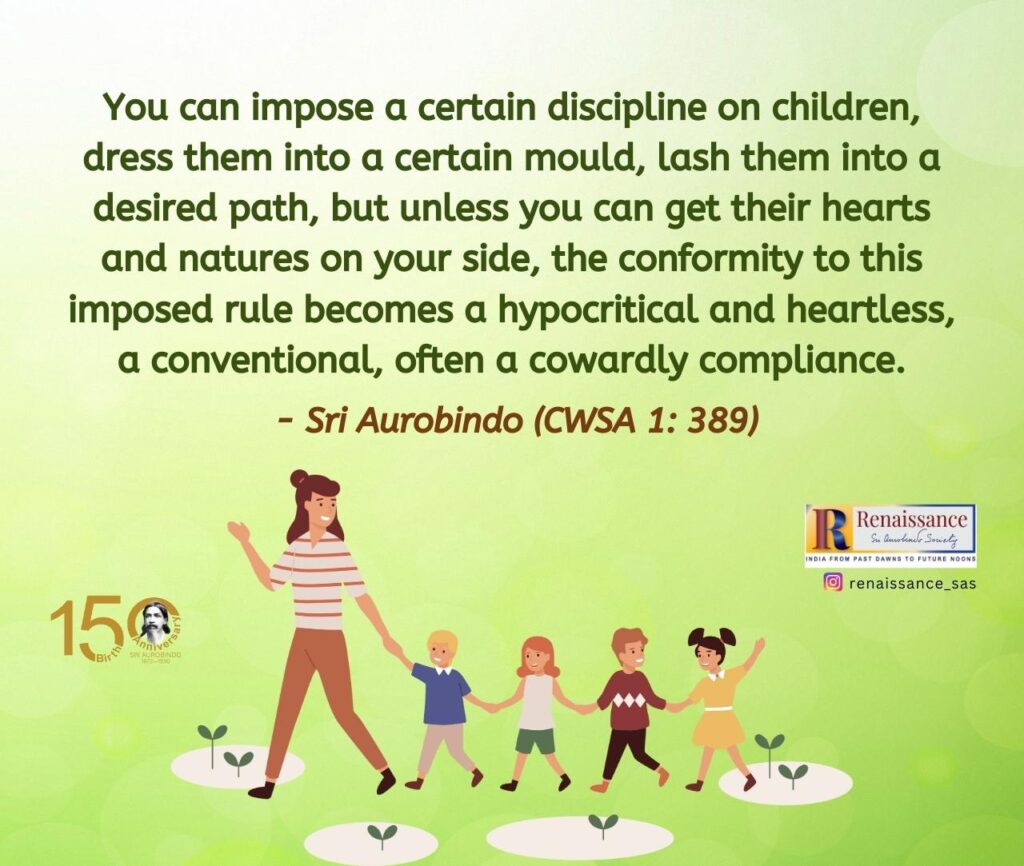
An education guided by the Indian view on aim of human life and the principle of gradual development of the human being through life experiences will naturally encourage this approach of providing meaningful opportunities for the learner’s moral development.
The opportunities for moral development must also be reflective of an important principle of true teaching given by Sri Aurobindo – ‘from Near to Far’.
Unless the children, adolescents and young adults are able to reasonably and consciously work through the moral dilemmas arising in their most immediate life-context (e.g., situations arising in their relationship with family members, peers and friends), they cannot be prepared to deal with any larger issues facing the society or humanity. Unless they are given an opportunity to struggle with inter-personal conflicts in a thoughtful and reflective manner in order to arrive at a harmonious solution, they will be unable to even comprehend the multiple layers of the larger conflicts facing the society and the world.
This requires that children and youth are not shown the quick and easy way of suppressing or denying or rejecting the conflicts that will naturally occur when human beings come into contact or interact with one another.
Instead, they should be shown – by example, by encouragement and by giving them an opportunity – to engage constructively and work around and with the conflicts, and grow into mutual understanding and a wider and more inclusive synthesis of viewpoints. To quote from Sri Aurobindo:
. . . the best way is to put the child into the right road to his own perfection and encourage him to follow it, watching, suggesting, helping, but not interfering. . .
The old Indian system of the guru commanding by his knowledge and sanctity the implicit obedience, perfect admiration, reverent emulation of the student was a far superior method of moral discipline. It is impossible to restore that ancient system; but it is not impossible to substitute the wise friend, guide and helper for the hired instructor or the benevolent policeman which is all that the European system usually makes of the pedagogue.
~ CWSA, Vol. 1, p. 390

To summarise, a thoughtfully organised vital education is critical to help the young learner grow into a mature individual with a deeper awareness of the working of the various vital movements within – impulses, reactions, desires, instincts, actions – and a greater understanding and experience of practicing self-restraint.
By emphasising and facilitating the awakening and building up of the will necessary to regulate and control the pull of various movements within, instead of a moralistic preaching, such an education of the vital has lasting impact on the overall growth of the individual, and more particularly on one’s idea of how to lead a life of self-control.
Concluding Thoughts
A remarkable churning is taking place in India today. The contemporary Indian mind is making an attempt to re-discover the spirit of Indian civilisation, the soul of India. This may lead to a fair view of our heritage, a rational assessment of our past glory and failures, and perhaps also some misplaced chauvinistic pride. There is also a risk of cultural pride becoming the means to a regressive thinking about trying to imitate the past without a comprehensive understanding of the present challenges and future needs of the nation and the world. We must recall a valuable guidance from the Mother in this regard:
…we realise the value of ancient Indian things, but we are here to create something new, to bring down something that will be quite fresh for the earth. In this endeavour, if your mind is tied down to the ancient things, then it will refuse to go forward. The study of the past has its place, but it must not hamper the work for the future.
~ CWM, Vol. 12, p. 216
One consequence of this churning is a growing sense of disharmony in the Indian mind, and simultaneously a push to recover that harmony between who we are as a people and how we want to educate our future generations. We hear questions such as—how to Indianise our education? How can Indian spirit be more meaningfully integrated into education? Harmony in the Indian mind can be established only when we re-examine and re-think our education in the light of the essential principles of education and life that are emphasised in Indian culture.
Sri Aurobindo cautions that mere inclusion of the matter of Indian thought and culture in the field of knowledge does not make a system of education Indian. He emphasises the need to revive “the spirit, ideals and methods of the ancient and mightier India in a yet more effective form and with a more modern organisation.” (CWSA, Vol. 1, p. 369)
A truly national education necessary for true resurgence of Indian spirit must recognise that the soul, – or the psychic, to use Sri Aurobindo’s terminology, – is the first and foremost truth of an individual being, and this expresses itself through the outer instruments of mind, life-energy, and body. Thus, education must give a great value to appropriate care, growth and development of these outer instruments so that they rise up to realise their highest potential.
Watch:
Learner as a Soul-in-evolution and Dharma-centric Education
At the same time, while education must help distinguish and cultivate in an individual “a mental, an intellectual, an ethical, dynamic and practical, an aesthetic and hedonistic, a vital and physical being,” it must also recognise that “all these have been seen as powers of a soul that manifests through them and grows with their growth, and yet they are not all the soul, because at the summit of its ascent it arises to something greater than them all, into a spiritual being.” (CWSA, Vol. 1, p. 426). Indian vision recognises that this is how an individual gradually ascends to his or her ultimate divine self-hood.
While helping to develop a confident sense of identity, education must also bring an awareness in the learner that ego-self is merely the outermost layer of one’s being. And that there is a deeper self beyond the ego and its various constructs of multiple identities based on one’s ethnicity, gender, nationality, creed, profession, vocation, academic attainments, etc.
Learners must develop an awareness — and also an experience if possible — that it is only when one is in contact with one’s deeper self one begins to develop a true individuality independent of all the outer identity tags.
Education must create an awareness and facilitate an opening in the young minds and hearts for the fact that there is a personal inner truth, independent of and transcending all the layers of outer identity of the individual. And that the discovery of this inner truth through intense self-search and deep self-knowledge is a fundamental aim of human life.
Seen in this light, all life becomes a means of education, in order for us to walk the path of discovering and realising the aim of our life – individually and collectively. Each of the outer instruments of the being is developed and cultivated and refined through life-experiences and education.

The way to become conscious of each of our parts and their movements is constant observation and a sincere examination of our motivations, impulsions or intentions for all our choices, decisions and actions. The Mother emphasised that the primary work of all those entrusted with the task of educating children is to facilitate self-knowledge.
“Essentially, the only thing you should do assiduously is to teach them [the students] to know themselves and choose their own destiny, the path they will follow; to teach them to look at themselves, understand themselves and to will what they want to be. That is infinitely more important than teaching them what happened on earth in former times, or even how the earth is built, or even… indeed, all sorts of things which are quite a necessary grounding if you want to live the ordinary life in the world…”
~ CWM, Vol. 8, p. 182
The Mother and Sri Aurobindo envision a spiritually transformed man, a spiritually transformed humanity, and a spiritually transformed life on earth, a divine life.
It is this fulfillment of the man in this world, the inner and outer transformation that is necessary for this fulfillment, and the evolution of consciousness that facilitates such transformation that are behind Sri Aurobindo’s and Mother’s thoughts on Education and its aims. Education, in this light, becomes the means to prepare learners for such transformation, which requires that all parts of their being – physical, vital, mental, psychic and spiritual – are properly prepared and developed to manifest a harmonious and integral personality. The emphasis is more on integral development, instead of emphasising any one or two aspects of personality.
CONCLUDED.

READ: PART 1 & PART 2
~ Design: Beloo Mehra

